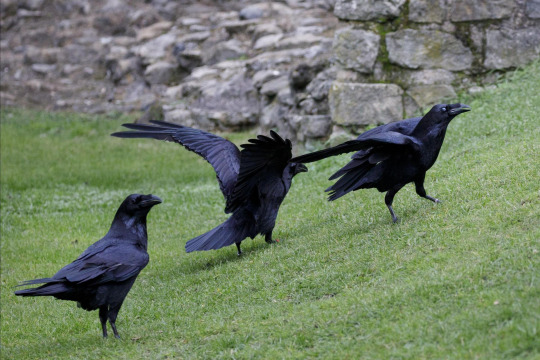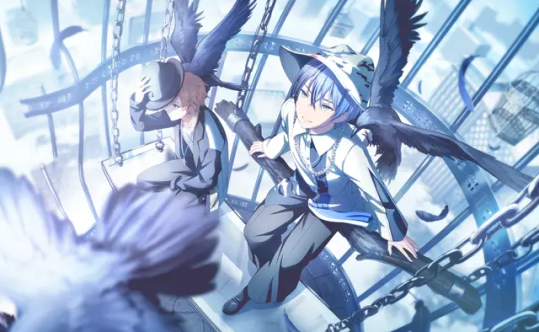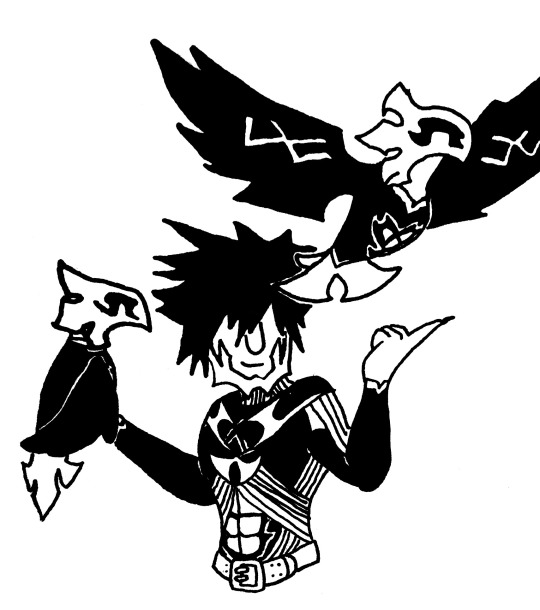#genus: corvus
Explore tagged Tumblr posts
Text







#poll#Class: Aves#Order: Passeriformes#Family: Corvidae#Genus: Corvus#Corvus Corax#Range: Nearctic#Range: Neotropical#Range: Palearctic#Range: Indomalayan
187 notes
·
View notes
Note
Would you be interested in doing an analysis of ravens?
The common raven or northern raven (Corvus corax) is a large all-black passerine bird. Some characteristics of a common raven daemon might be:
Loyal, dedicated [1]
Vigilant, aware, paranoid [2]
Bold, assertive, loud [3]
Adaptable, hardy [4,9]
Serious
Smart, sly, savvy [5]
Playful, cheeky [6]
Affectionate
Intuitive [7]
Expressive, manipulative [8]

Common ravens usually travel in mated pairs, although young birds may form flocks.
Ravens are quite vigorous at defending their young and are usually successful at driving off perceived threats.
Common ravens attack potential predators by flying at them and lunging with their large bills.
Common ravens are omnivorous and highly opportunistic: their diet may vary widely with location, season and serendipity.
The brain of the common raven is among the largest of any bird species.
Juvenile common ravens are among the most playful of bird species. They have been observed to slide down snowbanks, apparently purely for fun. They even engage in games with other species, such as playing catch-me-if-you-can with wolves, otters and dogs.
Common ravens are one of only a few wild animals who make their own toys. They have been observed breaking off twigs to play with socially.
Like other corvids, the common raven can mimic sounds from their environment, including human speech. Non-vocal sounds produced by the common raven include wing whistles and bill snapping.
Common ravens live in a wide array of environments but prefer heavily contoured landscapes.
8 notes
·
View notes
Text
A Collection of Alternate Vigilante Names For Tim Because Red Robin Is Boring And He Deserves Better
Jacobin (hummingbird species)
Tiercel (a male falcon)
Peregrine (like the falcon)
Accipiter (genus name for sparrowhawks)
Aquila (genus name of eagles)
Cormorant (type of seabird)
Kestrel (small species of falcon)
Cardinal (small red bird)
Blackbird (small passerine bird)
Corvus (genus name for corvids)
Rook (species of corvid, also the chess piece)
Jackdaw (close relatives to corvids)
Crow (species of corvid)
Conspiracy (group of ravens)
Kea (species of parrot)
Wyvern (dragon with 2 wings and 2 legs)
Atrax (genus name of funnel web spiders)
Atheris (genus name of bush vipers)
Cerastes (genus name of horned vipers)
#dc#dc comics#tim drake#also Drake isn't a bad name#y'all are just mean#lmao#ive seen cardinal and atheris used before#personally i don't like cardinal for tim but i put it in there anyway for fairness#I'm partial to tiercel and jacobin myself#jacobin even has most of robin in it so he can keep that
75 notes
·
View notes
Text
Metaphor: ReFantazio has a cast of wonderful characters and in looking up the origins of some of their names I noticed that most of them are named of plants or animals. So I had a category 2 autism moment and compiled a list of them and where their names came from because I love details like this. Tell me if I missed any!
Under the cut for some spoilers
Plants:
Gallica: (Rosa Gallica, also known as the french rose)
Eiselin Burchelli Meijal Hulkenberg (Burchellia bubalina, or wild pomegranates)
Juani "Junah" Cygnus (Ajwain, known by other names such as bishop's weed and carom)
Basilio Magnus (Basilio is equivalent to the name "Basil")
Catherina Grann (Catherina is a variety of white tulips)
Cercis Klinger (Cercis is a genus of plants in the pea family known as "redbuds")
Cirsium Zorba (Cirsium is a genus of thistles)
Joanna Calendula (Calendula is a genus of the daisy family. its members are commonly called marigolds)
Aestivum Forden (Triticum Aestivum, common wheat)
Idaeus Glodell (Rubus Idaeus is the European Red Raspberry)
Milo Adriano Narcissus Maurizio - (Aside from the obvious, Narcissus is a genus of flowers commonly known as daffodils)
Roger Arctium Ward (burdock is from the Arctium family)
Julian Ruta Castillion (Ruta is rue)
Loveless Muscar O'Shea (Muscar comes from Muscat, a variety of grapes used to make moscato wine)
Lina Kayden (The name "Lina" has a different meanings depending on the language. Some possible meanings include: "palm tree", "olive crown" or "flax")
Animals
Leon Strohl da Haliaetus (the osprey, Pandion haliaetus)
Arvid "Grius" Alces (The moose is Alces alces, the only animal in the genus Alces)
Heismay Noctule (Nyctalus, a genus of insectivorous bats are commonly called "noctule bats")
Euphausia "Eupha" Etoreika (Euphausia is the largest genus of krill)
Neueirus "Neuras" Corax (Corvus corax, the common raven)
Alonzo Crotalus (Rattlesnakes belong to the genus Crotalus)
Elphas Maxim Bardon (His name is derived from Elephas maximus, the asian elephant)
Brigitta Lycaon (Lycaon is a genus of canines of which the African wild dog, Lycaon pictus, is the only extant member of)
Fabienne Vulpes (Vulpes is the genus of "true foxes")
Rella Melancoryphus Cygnus (Reversed, Cygnus melancoryphus is the black-necked swan)
Gruidae (The crane family is Gruidae)
Ovis Gideaux (Ovis are sheep)
Rudolf Krause (Rudolf means "glory-wolf")
Goddard Gunnel (Gunnels are a group of fish in the family Pholidae)
Louis Guiabern Charadrius (Charadrius is a genus of wading plovers)
#Metaphor Refantazio#m:tf#Metaphor Refantazi spoilers#m:tf spoilers#the one i cant figure out is jin dulls#what the fuck is cerchine?
111 notes
·
View notes
Note
my grandfather used to, whenever he'd hind an ant hill, clap his hands over it to alarm the ants. and when theyd spray their defensive stinky stuff, he'd rub it all over his arms and face.
supposed to be a good health thing, dont remember for what tho🤔
are you and your grandfather, by any chance, members of the crow and raven genus Corvus?
358 notes
·
View notes
Text

[2927/11080] Daurian jackdaw - Coloeus dauuricus
Note: Clements places this bird in the genus Corvus.
Order: Passeriformes Suborder: Passeri Superfamily: Corvoidea Family: Corvidae (corvids)
Photo credit: Vincent Wang via Macaulay Library
#birds#Daurian jackdaw#Passeriformes#Passeri#Corvoidea#Corvidae#Coloeus#birds a to z#undescribed#25% - 50%#emberizoidea#corvus
148 notes
·
View notes
Text
YES OKAY!
Cyanocitta is a genus in the family Corvidae, the family of birds called corvids, like crows, ravens, magpies, and jays. It basically means 'dark blue jay', cyan being 'dark blue' (coming from Greek kuanos) and citta being 'jay' (coming from Greek kissa). The two species in this genus are C. cristata (blue jay) and C. stelleri (Steller's jay). And for the blue jay, 'cristata' comes from the Latin word crista which means 'crested'.
They live just about all over North America, Steller's jays being in the west, and blue jays more to the east. And where they overlap, there tends to be interspecies breeding, which I believe ends up with the Steller's jays that have some white on them like blue jays, or blue jays that have more black like Steller's jays. And there are a total of thirteen subspecies of Steller's jays, and four subspecies of blue jays, which in the case of Cyanocitta is basically just the different colour variations throughout different areas of the range of each species.
guys why do I always have the urge to just go "did you know there are only two species in the genus cyanocitta" even to people I've already told it all to
#can you tell cyanocitta is one of my favourite genera .....#i've read this information over and over again and it's definitely the genus (at least of birds) that I know the most about atm#uh but yes this is all from memory sigh. and I can go more into depth about some of it too#i love greek and latin and knowing how that fits into taxonomy and making connections between different species because of that#like the American crow and the mallard and the platypus#I read the scientific name of the mallard (Anas platyrhynchos) and recognized parts of it right away#American crow is Corvus brachyrynchos and platypus is Ornithorhynchus anatinus#and ornithology is the scientific study of birds. so. there are lots of similarities between all those#but yeah lol#birds#guh....#cyanocitta#cyanocitta cristata#cyanocitta stelleri#blue jay#stellers jay#steller's jay
10 notes
·
View notes
Text
Meet the hooded crow

Also known as scald-crow or hoodie, a bird species in the genus Corvus. Found across Europe, as well as parts of the Middle East. Represents deep spiritual transformation associated with intuition and psychic abilities.
30 notes
·
View notes
Text




#poll#Class: Aves#Order: Passeriformes#Family: Corvidae#Genus: Corvus#Corvus Splendens#Range: Indomalayan#Range: Afrotropical#Range: Palearctic
27 notes
·
View notes
Note
So in the spirit of the season what are some good creepy/scary dinosaur facts?
I mean, I'm Jewish, so for me its still Shake a Citrus Fruit at G-d and Live in a Tent Season, *however*
Have you met the Vampire Finch?
How about Shrikes, which impale their victims?
Then there's the fact that Ducks have Corkscrew Penises
As we all know, members of the genus Corvus can remember humans and will hunt you tf down if you cross them
And who can forget the Bearded Vulture, which just straight up eats bones!
151 notes
·
View notes
Text
Birds in Sekai - 17




Card 482, From Now On, Always; Card 483, Midnight Making; Card 484, It's About The Particulars, No?; Card 485, Nuanced Language
These birds are:
Crows and/or ravens, genus Corvus, family Corvidae, order Passeriformes.
As mentioned in BiS 12, these birds are notoriously hard to distinguish from each other in real life. In this card set, the birds are drawn with both crow and raven-associated traits, making their distinctions even blurrier.
This is the first bird-themed card set, so I've grouped all the cards featuring birds into one post.
#birds in sekai#rhythm games#project sekai#pjsk#vivid bad squad#vocaloid#aoyagi toya#shinonome akito#azusawa kohane#kaito#vbs kaito#shiraishi an#birds#bird arts#corvid
13 notes
·
View notes
Text








Indian paradise flycatcher
The Indian paradise flycatcher (Terpsiphone paradisi) is a medium-sized passerine bird native to Asia, where it is widely distributed. As the global population is considered stable, it has been listed as Least Concern on the IUCN Red List since 2004. It is native to the Indian subcontinent, Central Asia and Myanmar.
Males have elongated central tail feathers, and a black and rufous plumage in some populations, while others have white plumage. Females are short-tailed with rufous wings and a black head.[2] Indian paradise flycatchers feed on insects, which they capture in the air often below a densely canopied tree.
The Indian paradise flycatcher was formally described in 1758 by the Swedish naturalist Carl Linnaeus in the tenth edition of his Systema Naturae under the binomial name Corvus paradisi. The Indian paradise flycatcher is now one of 17 paradise flycatchers placed in the genus Terpsiphone that was introduced in 1827 by the German zoologist Constantin Gloger. Paradise-flycatchers were formerly classified with the Old World flycatcher in the family Muscicapidae, but are now placed in the family Monarchidae together with monarch flycatchers. Until 2015, the Indian paradise flycatcher, Blyth's paradise flycatcher, and the Amur paradise flycatcher were all considered conspecific, and together called Asian paradise flycatcher.
Adult Indian paradise flycatchers are 19–22 cm (7.5–8.7 in) long. Their heads are glossy black with a black crown and crest, their black bill round and sturdy, and their eyes black. Females are rufous on the back with a greyish throat and underparts. Their wings are 86–92 mm (3.4–3.6 in) long. Young males look very much like females but have a black throat and blue-ringed eyes. As adults, they develop up to 24 cm (9.4 in) long tail feathers with two central tail feathers growing up to 30 cm (12 in) long drooping streamers.
#beauty of nature#deathmothblog#nature#wildlife#animals#bird#artists on tumblr#Indian paradise flycatcher
27 notes
·
View notes
Text
JTTW Chapter 80 Thoughts
Chapter 80 for the @journeythroughjourneytothewest Reading Group!
Thus far most of the yaoguai the pilgrims have encountered either lived in mountains or at least came from a mountain originally, so Tang Sanzang’s fears here are very valid.
Oh, birdies!
Upon closer investigation parrot is very much correct. While not a specific species of parrot, it seems to be narrowed down to the family of Psittacidae or holotropical parrots which are true parrots that among a bunch of other places live in Southeast Asia!
Cuckoo is also correct! Specifically of the genus Cercococcyx, which four types of cuckoo belong to. Those are the Whistling Long-tailed Cuckoo or Cercococcyx lemaireae and the Dusky Long-tailed Cuckoo or Cercococcyx mechowi who are sometimes not recognized as distinct from each other, as well as the Barred Long-tailed Cuckoo or Cercococcyx montanus and the Olive Long-tailed Cuckoo or Cercococcyx olivinus.
The Olive Long-tailed Cuckoo of these looks like this, which the others are similar in appearance to as well.

Funfact, apparently the characters used for cuckoo are also used for a species of Azalea! Rhododendron simsii to be specific, which are native to East Asia and sometimes made up looking like a bonsai.

Magpie, yes, the Eurasian Magpie aka Common Magpie or Pica pica! A very pretty bird too.

Crow is equally accurate. The genus of Corvus, very smart birds!
Last but not least oriole, which is also correct. Specifically the Yellow Oriole or Oriolus Chinensis, which has showed up before!
Tang Sanzang finally listens to Sun Wukong on these matters! That is what we call character growth!
The banter is particularly good this chapter, plenty of wit and even more open communication. They have really grown close with each other talking and joking so casually.
It seems like that priest is not very familiar with the concept of personal space. Also the marks of beauty that are focused on here are very much tied to Buddhism, the ears being pretty obvious but the long arms counting too as the German translation notes.
#xiyouji#journey to the west#jttw#tang sanzang#jttw reading group#jttw book club#bird#cuckoo#magpie#azalea
9 notes
·
View notes
Text
⚧ about my alterhumanity ⎇
the main labels I use for myself are nonhuman, therian, holothere and transspecies
I physically identify as a fae (changeling), fallen angel (more specifically the goethic demon Focalor), and vampire. My changeling identity extends to my therianthropy, hence why I consider myself a holotheric therian. My most prominent theriotypes are coyote and domestic cat.
my physical identity is a mix of philosophical and literal, and is also deeply connected to my identity as a transgender and transspecies being
I'm also a psychological fictionkin. I consider my fictional IDs/main types to be Kris (Deltarune) and Cyn (Murder Drones)
I'm a linker, and consider all my chosen identities to be quoiluntary to some extent
an extensive list of my types is right under the cut ↓

Paroulink:
Fae/changeling
Theriotypes:
Coyote (canis latrans)
Feline cladotherian (felidae)
Leporid cladotherian (leporidae)
Rufous-bellied thrush (turdus rufiventris)
Blue and yellow macaw (ara ararauna)
Cockatiel (nymphicus hollandicus)
Dragonfly nymph (zygoptera)
Sea Drake (theriomythic)
Western dragon (theriomythic)
Cambitheriotype:
Dog (canis lupus familiaris)

Kintypes:
Werecat
Demon/fallen angel (Focalor)
Griffin
Vampire
Mermaid
Centaur
Songkin:
Sabiá Lá Na Gaiola (Nursery rhyme)
Coyotes - Modest Mouse
Fictotypes:
Kris (Deltarune)
Cyn (Murder Drones)
V (Murder Drones)
Twilight Sparkle (MLP)
Kitty Cheshire (EAH)
Kiara (The Lion King II)
Mudfur (Warrior Cats)
Noone (TSON)
Spring Bonnie (FNAF)
Funtime Foxy (FNAF)
Paratype:
Wildcat/Cecile (Wolf 2021)

Birds belonging to the corvus genus
Hearttypes:
Cat card (Inscryption)
Her's - I'll Try (song)
Her's - Dorothy (song)
Synpaths:
Chihiro Fujisaki (Danganronpa)
Powder (Arcane)
Ralsei (Deltarune)
Ravenpaw (Warrior Cats)
Thrushpelt (Warrior Cats)
Hearthomes:
Atlantic Forest
Temperate Forest
Arctic
Hometown (Deltarune)
Waterfall (Undertale)
Fredbear's Family Diner Freddy Fazbear's Pizza '87
Funtime Auditorium (FNAF SL)

Linktypes:
Horse (equus caballus)
Wolf (canis lupus)
Werewolf
White-tailed deer (odocoileus virginianus)
Max (Internecion Cube)
Shadow Freddy (FNAF)
Copinglink:
Qilin

Questioning:
Seal (possibly leopard, harbor, or harp, but I'm still researching different species)
#alterhuman#therian#otherkin#otherhearted#otherlinker#linktypes#theriotypes#kintypes#kinlist#holothere#nonhuman#physically nonhuman#transspecies#physical therian#alterbeing
10 notes
·
View notes
Text
i think the misleading thing about corvids is the fact most corvuds are corvus, so you have birds like fish crows (corvus ossifragus) and this makes people think oh yeah crows are the only corvids! and like it makes sense because corvus as a genus does make up i think 50 species. but like. nah
14 notes
·
View notes
Text

Ink October day eight: Raven
Plunder; rapine; robbery; rapacity; furious violence.
Plunder; prey; food obtained with rapacity.
A bird of the larger species of the genus Corvus, having the feathers of the throat lanceolate and distinct from one another.
#Archraven#kingdom hearts vanitas#kh vanitas#Vanitas#vanitas kh#vanitas kingdom hearts#kingdom hearts#kh#unversed#ink october#blue boi draws#ink October 2023#ink October 2023 day 8#please don’t ask me what he’s wearing I didn’t want to draw his canon fit#I love Archravens they’re probably one of if not the best unversed to me#that being said fucking hate fighting them. stop stealing my orbs motherfuckers
98 notes
·
View notes